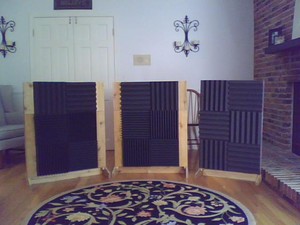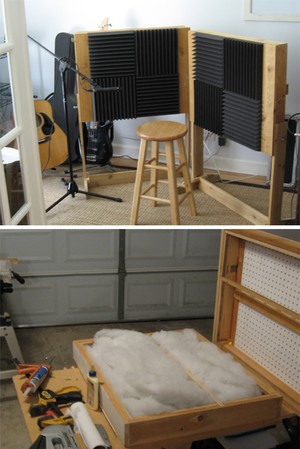Walt
Panels Update
Oct 9, 2010

After getting good results with my panels I decided to build some more. The original ones were put together with materials I already had in my garage and some Auralex foam I had forgotten about in my storage room, so I was limited to a total of 8' square.
I was able to scrounge up just enough cedar from my woodpile to build 2 more 2' sq. modular sections that can attach to and extend the original panels, as well as an additional 6' sq. panel. I found Foam Factory, which delivered acoustic foam @ $1.20/sqft
I now have about 20' of sound-absorbing coverage, which can be arranged in multiple configurations depending on what or where I'm recording. For acoustic guitar or vocals, I can build a 3-sided booth that's about 5' high.
Here are some samples demonstrating the results with and without the panels:
Without Panels |
With Panels
Share
Post comment
Like
Panel Absorbers
Sep 1, 2010

I have recently switched over to recording at 24bits/48k after picking up a mic preamp with A/D converters. The added clarity this brings to my recordings is nice, but it also now reveals the short reflections of my untreated room.
Since I have no interest in soundproofing the room, I did some research and came up with the idea of building these panel absorbers (thanks mainly to John Sayers--https://johnlsayers.com/Recmanual/Titles/Acoustics2.htm).
The idea is to isolate the mic'd source from room acoustics while not introducing a reflective surface that leads to phase cancelling, etc. For close micing with a unidirectional, an absorptive surface of a few feet square should reduce both the sound making it out to the room from the source as well as reverberations coming back to the mic.
These panels are based on the Hemholtz resonator, which is essentially some chamber that traps sound due to the pressure differential that exists on opposing sides of the opening or port. My application is a 2.5'W X 2'H X 3.5"D insulated & sealed cedar box with a pegboard surface (the holes are the "ports").
According to the dimensions of the box and the perforated surface, this should be good for absorbing sounds down to about 100hz, with peak resonance somewhere in the midrange frequencies. I put Auralex foam on top of the pegboard for another layer of absorption across the spectrum. The stands allow the panels to be raised up to about 4'.
Since they are absorbers the maximum benefit seems to come by positioning them so that the sound being recorded is pointed directly at the panels, with the mic then in between the panels and the sound souce.
My initial tests (mic'd guitar cab / mic'd acoustic guitar) showed much better results than I expected. Room reflections went from "obvious" through monitors to "just noticeable" when soloing the track thru headphones.
Share
Post comment
Like